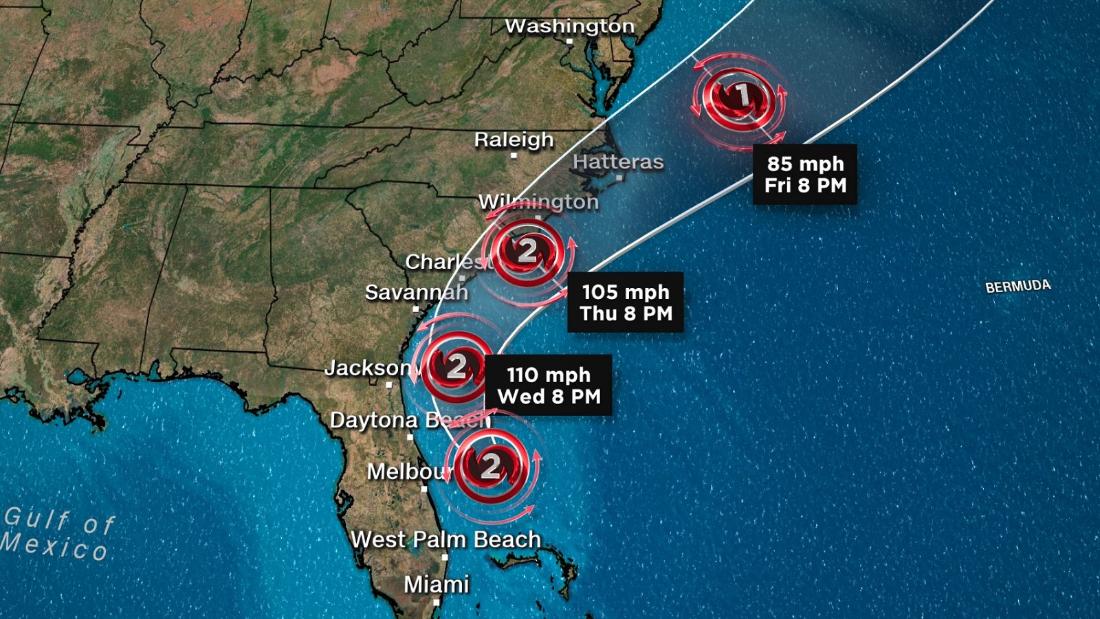
Current forecasts show the storm remaining in the Atlantic Ocean as it churns along the edge of the coasts of Florida, Georgia and the Carolinas.
But a little wobble west and it could make landfall in South or North Carolina, CNN meteorologist Judson Jones said.
The Category 2 storm's outer bands were continuing to lash Florida early Wednesday morning, passing east of Cape Canaveral, as the hurricane moved at 6 mph north-northwest toward Georgia's coast, where it will dump up to 6 inches of rain.
"Even if Dorian does not make landfall, hurricane-force winds are expected to reach portions of the coast from central Florida to North Carolina," the National Hurricane Center said, warning also of surge-related flooding and "large and destructive waves."
On its way to the US, the hurricane swept over the Bahamas, ravaging neighborhoods and devastating entire towns. Dorian's death toll, which officials fear will rise sharply as search and rescue operations begin Wednesday, stands at seven people, Prime Minister Hubert Minnis said.
It left "all docks destroyed and every boat sunk," in some parts of the islands, the Hope Town Volunteer Fire & Rescue said.
"We have been attacked by a vicious, devastating storm (from which there was no defense)," Minnis told CNN.
The storm has brought on the greatest national crisis in the country's history, Minnis said.
States have been preparing
The East Coast states have been preparing for the monster storm's uncertain path and arrival for nearly a week.
Eleven Florida coastal counties were under mandatory evacuation orders Tuesday night as the state felt the storm's impacts.
"These potential impacts, including flooding, structural damage, storm surge and serious beach erosion in our coastal communities cannot be understated," Gov. Ron DeSantis said.
In Georgia, Gov. Brian Kemp issued a mandatory evacuation order for six coastal counties.
"We're looking at a 4 to 7 foot storm surge which is very high, higher than some of the more catastrophic storms that we've seen from a water perspective in the past," Kemp said Tuesday evening.
"We need people to evacuate," he said. "This is not a storm to mess with."
A major state interstate switched to a one-way evacuation route Tuesday as hundreds of thousands began evacuating the Georgia coast, CNN affiliate WSB reported.
Residents 'must leave now,' South Carolina officials warn
South Carolina Gov. Henry McMaster declared a state of emergency ahead of the storm, tweeting Tuesday night there was "no more time for hesitation."
The state's coastal areas will see life-threatening storm surge and dangerous winds, according to the hurricane center, "regardless of the exact track of Dorian's center."
The Carolinas aren't out of the woods yet in terms of landfall. The core of the hurricane could be "very near, or possibly over, the coast of South and North Carolina on Thursday and Friday," the hurricane center said.
"If you're in an evacuation zone you need to evacuate now," McMaster said.
The state's emergency management agency echoed those warnings.
Residents in designated evacuation areas must leave by Wednesday morning, the South Carolina Emergency Management Division said.
"Due to the increasing threat of dangerous conditions such as storm surge and high winds, now is the time to heed the evacuation order issued by Governor Henry McMaster," the agency said.
The federal government also granted North Carolina Gov. Ray Cooper's request for a federal disaster declaration ahead of the storm Tuesday.
"North Carolinians have faced tough storms before and we're taking every precaution to make sure we're prepared," Cooper said.
Earlier this week, the governor ordered evacuations from the barrier islands.
No comments:
Post a Comment